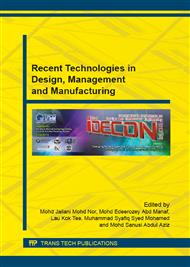p.566
p.571
p.579
p.584
p.589
p.594
p.599
p.604
p.609
Upgradable Design for Reduction of Production Cost and CO2 Emission - Case Study of a Laptop Computer
Abstract:
An upgrade product design method is one of the efficient design methods for reducing environmental loads caused by mass production, consumption, and disposal. This method seeks to design a product that can adapt to future required performance and functions via component upgrade by exchanging components in the early phase of design. Because considerations of future product performance and functions include uncertain design information, an accurate prediction is very difficult. Therefore, this study defines uncertain design information as ranged sets, and applies a preference set-based design method that can correspondingly obtain ranged sets of design solutions. In previous studies, proposed methods were focused on product performance enhancement without quantitative consideration of environmental loads. Hence, this study proposes an upgrade product design method that can address the enhancement of product performance, while concurrently reducing production cost and environmental load, which is herein strictly defined as the amount of CO2 emission. Finally, our proposed upgrade product design method is applied to a laptop PC design problem to demonstrate its utility.
Info:
Periodical:
Pages:
589-593
Citation:
Online since:
May 2015
Authors:
Keywords:
Price:
Сopyright:
© 2015 Trans Tech Publications Ltd. All Rights Reserved
Share:
Citation:


